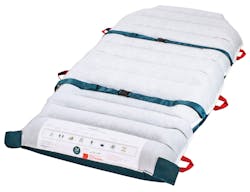Under pressure
The proper handling of patients in our healthcare facilities is more of a concern in 2023 than ever before.
Yes, we are living in an age that is synonymous with advances in methods and technologies, but we are also living in an era wherein the strain and pressure on healthcare workers are at unprecedented levels.
Thus, it is often the stressed and overworked nurse who is tasked with the vital role of routinely repositioning patients, lest they develop health risks from pressure ulcers or infection.
Yet, at the very same time, the members of our healthcare staffs are not only under pressure from performing positioning tasks properly (and in specific accordance with the specialized needs of patients), but all too often, from becoming the bearers of their own personal injuries, incurred from the harsh realities that often accompany the duties of moving the persons under their care.
In fact, while the very act of repositioning dependent patients in bed is the most common type of patient handling activity, it is also one that is accompanied by great potential danger, as evidenced by the high rates of musculoskeletal disorders in healthcare workers.
Calling all nurses
“Patient positioning challenges we are currently facing on the floor in nursing directly coincide with staffing shortages. As a nurse on the floor one of the primary problems we face along with our nurses’ aides is too large of a patient to staff ratio. Turning a patient every two hours may be needed, or ideal, and it is the responsibility of the floor nurse to make sure these care plans are followed and implemented by us and our nursing assistants.
“But as a working floor nurse accompanied by extremely hard-working staff, maintaining the consistency needed to follow through on every aspect of a care plan is sadly not real life in nursing. Nurses can have 20-40 patients in LTC at a time, and often aides can have 10-13 people to care for apiece. While the intention and goal are there to do everything right, in reality it is a different story with these types of ratios,” said Murtagh.
Patients with limited mobility, or who regularly demand repositioning, are typically kept on strict ‘turning schedules;’ such schedules are quite often set at intervals of 2 hours, though these times can certainly vary based upon a wide variety of patient specifications and/or limitations.
Murtagh emphasized that the window of opportunity for nurses and aides to perform such positioning duties is quite often a narrow one, and can potentially set a course for longer, and thus more negative reactions. She states:
“When units are running short for nurses and nurses’ aides, the time in between repositioning patient, and patient care itself, is inevitably increased. This means longer times wherein patients are in the same position and the likelihood of a pressure sore is much greater. Patients that have limits to their mobility, coupled with waiting longer times for their personal care, such as toileting or changing briefs, are then at an even greater risk for skin breakdown such as in the peri area or coccyx due to incontinence, which creates a portal for infection, as well as pain and discomfort for the patient.”
Simply put, nurses are constantly under pressure, and relieving pressure through patient positioning is just one of many tasks that they are called to regularly perform in high-stress environments. In cases where the numbers of staff members are dwindling or limited, the pressure on balancing countless duties (of which patient positioning technically only qualifies as one) can be hard to fathom.
The numbers don’t lie
McKinley was also adamant to point out the key role of education for hospital staff in ensuring that all the processes involved with moving and mobilizing patients is done with due diligence and care.
“We’ve learned that education is a fundamental component—which has led to our newly created resource hub with some sobering statistics and key tips to not only remind staff about the everyday risks of patient handling, but what they can do to mitigate them,” added McKinley.
Healthcare Purchasing News did not hesitate to take a deeper glance into AliMed’s resource hub, which included a detailed pamphlet on patient handling, entitled, “Making Safe Patient Handling Safer.”
In addition to providing many key insights on proper methods and strategies for directing and conducting the movement of patient (in a wide range of situations), the guide presented some very real numbers on the potential negatives the workforce can encounter in these critical and highly specific handling actions:
- As many as 20% of nurses who leave direct patient care positions do so because of risks associated with the work.2
- Patients are 100% heavier than 30 years ago, which places nurses at risk for patient-handling injuries such as neck or back strains. In spite of education and no-lift campaigns in the work unit, many nurses admit to moving patients alone due to the perception of time constraints.3
- Hospitals and nursing homes have become dangerous industries in the United States. According to the Bureau of Labor Statistics, hospitals have injury rates that are nearly double than that of the average of all private industries; the incidence of musculoskeletal disorders in hospitals in 2016 was 60.5 per 10,000 full-time workers compared with 29.4 per 10,000 full-time workers in all private industries. One of the most common sources of musculoskeletal disorders in hospitals involves moving the patients.4
Slip sliding away
When a patient is on the operating table, the necessity for proper positioning and limited movement weigh extra heavy, as even slight slides can have a potential grave impact on surgeries, especially procedures requiring specialized positions, such as laparoscopic GYN surgery.
“Patient sliding during laparoscopic GYN surgery can cause the surgeon to lose range of motion with the uterine manipulator requiring patient repositioning,” said Dan Allen, President of D.A. Surgical.
Allen proceeded to highlight how in certain positions (such as the Trendelenburg), the advanced robotic technologies of the modern OR can provide their own unique dilemmas.
“Surgical robots create additional unintended consequences as robotic arms do not compensate for patient sliding. This sliding results in the trocars acting as ‘meat hooks’ as they are used to restrain sliding patients on the table.”
Dr. Ali Ghomi, a well-renowned specialist in gynecologic procedures and robotic surgery, released a paper on this very subject, entitled “Robotics in Practice: New angles on safer positioning.” In the paper, Dr. Ghomi addresses the subject by stating: “Patient slippage during the use of fixed robotic trocars creates a serious potential for patient risk, as it can cause incisional tear, post- operative hernia formation, and increased postoperative pain secondary to over-stretching of the anterior abdominal wall.”
Specializing in the development of patient positioning solutions that are geared towards both conventional and robotic surgeries, D.A. Surgical’s TrenGuard Trendelenburg Patient Restraint was the recent focus of a 10-month, 503-patient study on Trendelenburg patient positioning. The study was a testament to the great potential in the ever-enhancing industry of patient positioning technology, as not one patient slid, suffered discomfort, or was injured.
Pressure to train to relieve the pressure from strain
When it comes to handling patients, positioning and pressure management go hand in hand, as the proper monitoring and conducting of patient movement will prevent the emergence of pressure wounds, which can lead to further, more complicated issues such as infections.
As an Infection Prevention Nurse, Lisa Murtaugh is very familiar with the necessary steps to prevent these sores, and she was quick to highlight the need for further education and training in the positioning methods required to prevent pressure management injuries.
“In the day-to-day environment in a typical LTC facility, pressure sores are taken very seriously. They are monitored, often photographed, and should always be documented on. So, on the floor, there is certainly focus on it; however, LPN and Nurses Aid Programs will be well served to highlight how important patient positioning is, as it feeds into so many other complex areas of patient care such as wounds and their dressing and management, infection control, safety, and respiratory issues. By having patients properly positioned, you will decrease the risk of aspiration pneumonia and/or pressure ulcers, among many other possible ailments.”
Murtagh also stressed the vital activity of learning about the specific conditions of each patient, as there are never two patients exactly alike, and, often, a wide range of preexisting conditions will demand more intensive actions in terms of patient positioning.
“Often, a patient will have specific orders for positioning, such as, for example, a hip replacement; in this case improper education on the positioning required poses the risk of dislocating the hip. Furthermore, patients with respiratory issues will have positioning recommendations due to increased risk for comorbidities, such as pneumonia if they are improperly positioned.”
Limited mobility and unlimited (negative) potential
Though they go by many names (pressure injuries, bed sores, pressure sores and decubitus ulcers) pressure ulcers result from force being applied to the surface of the skin, and normally occur over bony parts of the body, such as the heels or sacrum, just to name a few.
Thus, it is certainly no surprise that persons with limited amounts of mobility are those at greatest risk for such injuries, as they simply lack the physicality and/or health to reposition themselves under their own power.
However, it must be also realized and greatly emphasized that patients of all kinds are prone to be subject to pressure injuries, as surgical procedures routinely demand little to no movement, and can place great amount amounts of pressure on parts of the body that are vulnerable for any person.
“There is always risk for pressure ulcer development during a surgical procedure,” says Moss. “This has been a long-standing issue, and there should be more emphasis on the operative team to plan for the proper positioning of patients during surgeries. This is especially crucial for hours-long surgeries, like open heart (CABG) or solid organ transplants, where prolonged pressure on the skin and deep tissue from prolonged contact with a hard operating table surface can potentially lead to skin breakdown.”
Moss was firm in her stance on the need for further education regarding proper patient handling, referring to the notion that the staff is just as prone to perform mishaps in moving patients and incorrectly diagnosing pressure injuries as they are to encounter personal injuries from applying faulty techniques.
“There needs to be a greater emphasis on providing classroom education of frontline staff, RNs and nurse’s aides, on pressure ulcer prevention. There are “Skin Saver” programs where staff can learn about pressure ulcer prevention, early detection and treatment. All patient-facing staff, including RNs, nurse’s aides, transporters and radiology technicians, should learn about safe body mechanics to prevent them from sustaining back and other body injuries when performing patient care. The Environmental Health and Safety department, often referred to as “Life Safety” of a hospital should facilitate the provision of Body Mechanics classes to hospital and Nursing home employees. Safe handling of patients is an important part providing of a truly safe environment of care for our staff and patients.”
Moss was also inclined to stress another key (and often overlooked) role in the management of pressure wounds, and that is the vital duties performed by wound ostomy care nurses (WOCNs).
“Health care institutions often underestimate the vital role that wound ostomy care nurses (WOCNs) play in preventing and healing skin breakdown. WOCNs not only treat patients with pressure ulcers, but they also prevent skin breakdown in high-risk patients (i.e. those patients who are immobile, have poor nutrition, are incontinent of urine and/or stool, or who have altered mental status). These high-risk patients are often pressure ulcers waiting to happen.”
Putting the issue to beds
Suboptimal positioning of patients is a continual concern in all areas of healthcare facilities, as it remains a major contributor to injury and infection. Therefore, its proper execution is a fundamental function that must be always carried out at optimal levels.
The advances in technologies, specifically of the hospital beds themselves, is something that must be learned and practiced by staffs to ensure that the practice is not only performed but done so in the most effective way possible.
These ways and means not only protect the patient, but the healthcare worker as well.
“It is a major risk when staff don’t use the functions of the hospital bed that allow it to be raised, lowered, or otherwise positioned in a way so that stress on the healthcare worker body can be minimized or prevented entirely. Hospital beds are very advanced and specialized to perform a lot of tasks, like turning and positioning, that staff used to have to do manually,” stated Moss, who was quick to recall the times when she and her fellow co-workers were routinely manually hand-cranking hospital beds.
Hospital beds have come a long way in a very short time and possess capabilities today that are immeasurable in enabling proper patient positioning and care.
According to Moss, “nursing should evaluate a patient to see if they would benefit from one of many types of specialty beds. Hospitals usually have contracts with specialty hospital bed suppliers who can help determine which bed would be right for a patient with special needs. These beds can relieve pressure on patient skin and on the staff who care for them. The bed supplier rents out these beds to the hospital for as long as the patient needs it. The bed supplier will pick up the bed when it is no longer needed.”
Manual labor
HoverTech International specializes in the development of air-assisted technologies. The company’s HoverMatt Air Transfer Mattress enables lateral transfers, boosting, turning in bed, positioning in the OR and proning, and has enhanced safety measures that provides for the caregivers doing the moving.
Beal went on to highlight some of the potential issues that regularly accompany manually moving patients.
“The challenges pertaining to positioning has many variables,” she noted. “Patient size, mobility, and illness along with the loss of nursing staff can impact patient positioning and the unit where the patient is located. Positioning needs change depending on the patient. A critically ill patient in the ICU will require more positioning aids, and positioning aids must protect the patient and the nurse.
“In the Operating Room, we are navigating the movement of patients of ever-increasing size, and just a simple movement up’ toward anesthesia for intubation and back into position for the procedure requires manual labor. This often leads to staff injuries or the need for additional OR room resources.”
“There is a need for more education in the hospital setting to help decrease pressure injuries because these wounds are very complex,” Beal continued. “It can be difficult to identify and stage pressure injuries unless you are knowledgeable about pressure injuries or are a wound care nurse. A pressure injury may appear on the surface as a small slit, but when it is thoroughly assessed it is a wound that has exposed bone. More tools need to be developed to help the nursing team correctly identify and direct the correct treatment."






